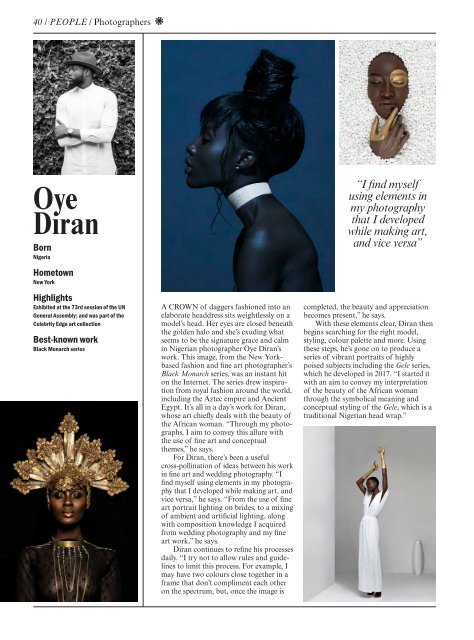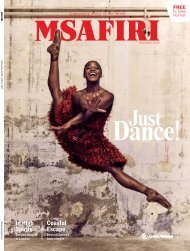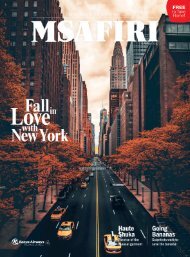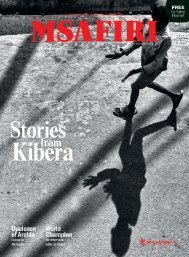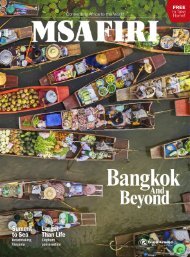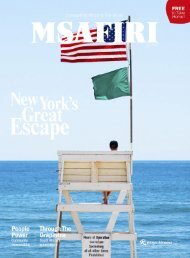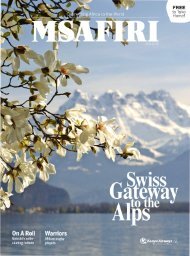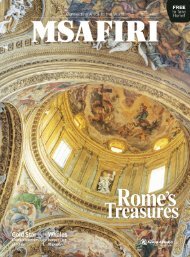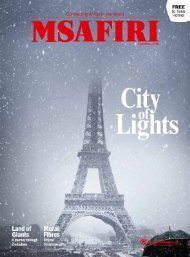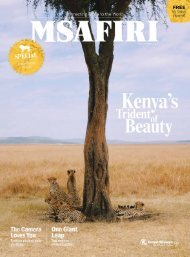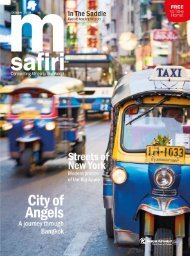You also want an ePaper? Increase the reach of your titles
YUMPU automatically turns print PDFs into web optimized ePapers that Google loves.
40 / PEOPLE / Photographers<br />
PEOPLE / 41<br />
“I would love to engage with<br />
more African cultures and<br />
create images and stories<br />
about our way of life”<br />
Oye<br />
Diran<br />
Born<br />
Nigeria<br />
Hometown<br />
New York<br />
Highlights<br />
Exhibited at the 73rd session of the UN<br />
General Assembly; and was part of the<br />
Celebrity Edge art collection<br />
Best-known work<br />
Black Monarch series<br />
A CROWN of daggers fashioned into an<br />
elaborate headdress sits weightlessly on a<br />
model’s head. Her eyes are closed beneath<br />
the golden halo and she’s exuding what<br />
seems to be the signature grace and calm<br />
in Nigerian photographer Oye Diran’s<br />
work. This image, from the New Yorkbased<br />
fashion and fine art photographer’s<br />
Black Monarch series, was an instant hit<br />
on the Internet. The series drew inspiration<br />
from royal fashion around the world,<br />
including the Aztec empire and Ancient<br />
Egypt. It’s all in a day’s work for Diran,<br />
whose art chiefly deals with the beauty of<br />
the African woman. “Through my photographs,<br />
I aim to convey this allure with<br />
the use of fine art and conceptual<br />
themes,” he says.<br />
For Diran, there’s been a useful<br />
cross-pollination of ideas between his work<br />
in fine art and wedding photography. “I<br />
find myself using elements in my photography<br />
that I developed while making art, and<br />
vice versa,” he says. “From the use of fine<br />
art portrait lighting on brides, to a mixing<br />
of ambient and artificial lighting, along<br />
with composition knowledge I acquired<br />
from wedding photography and my fine<br />
art work,” he says.<br />
Diran continues to refine his processes<br />
daily. “I try not to allow rules and guidelines<br />
to limit this process. For example, I<br />
may have two colours close together in a<br />
frame that don’t compliment each other<br />
on the spectrum, but, once the image is<br />
“I find myself<br />
using elements in<br />
my photography<br />
that I developed<br />
while making art,<br />
and vice versa”<br />
completed, the beauty and appreciation<br />
becomes present,” he says.<br />
With these elements clear, Diran then<br />
begins searching for the right model,<br />
styling, colour palette and more. Using<br />
these steps, he’s gone on to produce a<br />
series of vibrant portraits of highly<br />
poised subjects including the Gele series,<br />
which he developed in 2017. “I started it<br />
with an aim to convey my interpretation<br />
of the beauty of the African woman<br />
through the symbolical meaning and<br />
conceptual styling of the Gele, which is a<br />
traditional Nigerian head wrap.”<br />
FREEDOM AND honesty are essential<br />
parts of the creative process for Londonbased<br />
Nigerian photographer Ade<br />
Okelarin who goes by the moniker, Àsìkò.<br />
“I believe that this is how we’re able to<br />
create the truest form of our art. They free<br />
the imagination and allow us to go beyond<br />
the constraints of our boxes,” he says.<br />
With degrees in Chemistry and Bioinformatics<br />
under his belt, Àsìkò picked up<br />
a camera during his free time away from<br />
his programmer gig in the pharmaceutical<br />
industry. Starting off by photographing<br />
landscapes, he soon progressed to selfportraiture.<br />
“It revealed my more creative<br />
and conceptual side,” he says. “I began to<br />
incorporate emotional anchors into my<br />
work.” Àsìkò found that photography<br />
allowed him to explore his identity as an<br />
African living in Europe.<br />
His work comes across as textured and<br />
atmospheric, each portrait possessing a<br />
hint of grittiness. Àsìkò has trained his lens<br />
on various topics, including an exploration<br />
of the African way of life through myths<br />
and legends, as well as harmful cultural<br />
practices, such as female genital mutilation.<br />
The latter inspired his first solo exhibition,<br />
“Conversations”, which showed at<br />
London’s Gallery of African Art.<br />
“The challenges came when hearing<br />
some of the harrowing stories of women<br />
who had experienced such practices,” he<br />
says. “The fact that I’m not a woman made<br />
me question the validity of what I was<br />
creating. I did come to a point of understanding<br />
that the images are also about<br />
my experiences looking in on womanhood;<br />
so I might not be a woman, but I can<br />
empathise with women and I speak from<br />
my emotions about the subject matter.”<br />
Àsìkò’s plans for the year involve<br />
travelling to African countries in a bid to<br />
document their rich and diverse heritages.<br />
“I would love to engage with more African<br />
cultures and create images and stories<br />
about our way of life. I am fascinated by<br />
it all,” he says.<br />
Àsìkò<br />
Born<br />
London<br />
Hometown<br />
London<br />
Highlights<br />
Exhibited at Gallery of African Art (London)<br />
and Rele Gallery (Nigeria); and was<br />
nominated for the Creative Communicator<br />
Of The Year award at the 2011 Style Awards<br />
Best-known work<br />
Layers series; Adorned series


